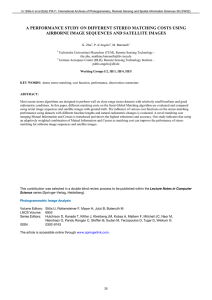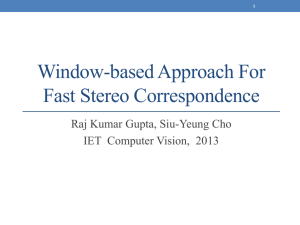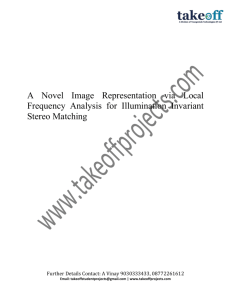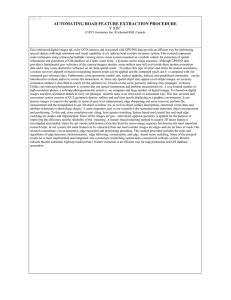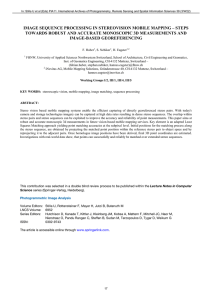Document 13135684
advertisement
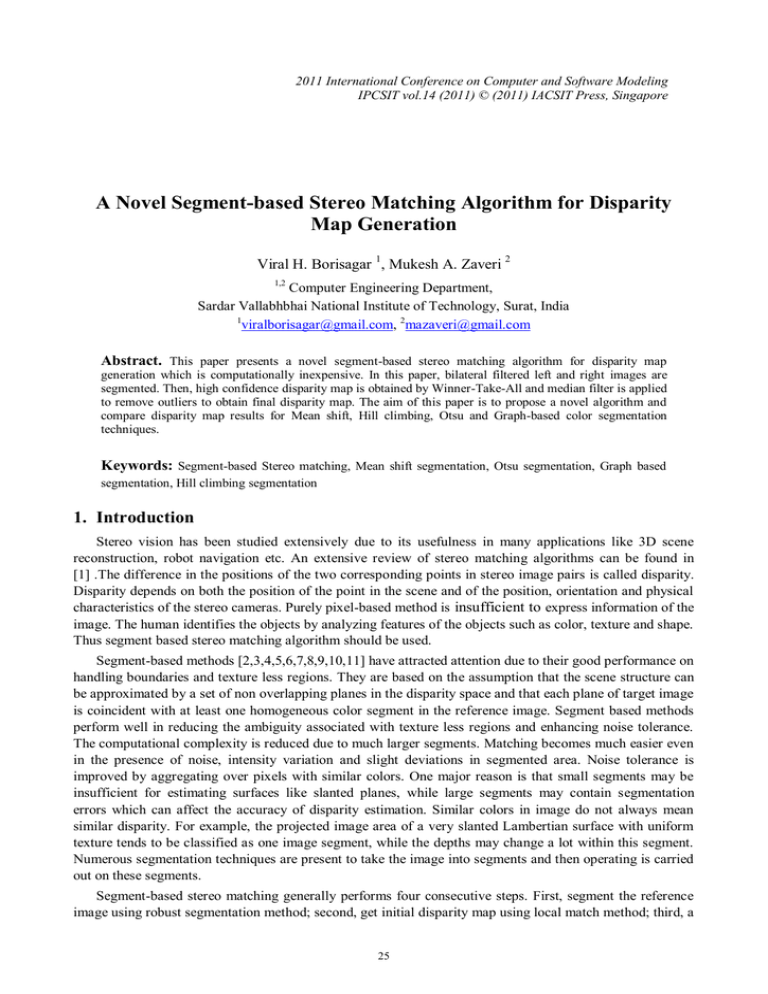
2011 International Conference on Computer and Software Modeling IPCSIT vol.14 (2011) © (2011) IACSIT Press, Singapore A Novel Segment-based Stereo Matching Algorithm for Disparity Map Generation Viral H. Borisagar 1, Mukesh A. Zaveri 2 1,2 Computer Engineering Department, Sardar Vallabhbhai National Institute of Technology, Surat, India 1 viralborisagar@gmail.com, 2mazaveri@gmail.com Abstract. This paper presents a novel segment-based stereo matching algorithm for disparity map generation which is computationally inexpensive. In this paper, bilateral filtered left and right images are segmented. Then, high confidence disparity map is obtained by Winner-Take-All and median filter is applied to remove outliers to obtain final disparity map. The aim of this paper is to propose a novel algorithm and compare disparity map results for Mean shift, Hill climbing, Otsu and Graph-based color segmentation techniques. Keywords: Segment-based Stereo matching, Mean shift segmentation, Otsu segmentation, Graph based segmentation, Hill climbing segmentation 1. Introduction Stereo vision has been studied extensively due to its usefulness in many applications like 3D scene reconstruction, robot navigation etc. An extensive review of stereo matching algorithms can be found in [1] .The difference in the positions of the two corresponding points in stereo image pairs is called disparity. Disparity depends on both the position of the point in the scene and of the position, orientation and physical characteristics of the stereo cameras. Purely pixel-based method is insufficient to express information of the image. The human identifies the objects by analyzing features of the objects such as color, texture and shape. Thus segment based stereo matching algorithm should be used. Segment-based methods [2,3,4,5,6,7,8,9,10,11] have attracted attention due to their good performance on handling boundaries and texture less regions. They are based on the assumption that the scene structure can be approximated by a set of non overlapping planes in the disparity space and that each plane of target image is coincident with at least one homogeneous color segment in the reference image. Segment based methods perform well in reducing the ambiguity associated with texture less regions and enhancing noise tolerance. The computational complexity is reduced due to much larger segments. Matching becomes much easier even in the presence of noise, intensity variation and slight deviations in segmented area. Noise tolerance is improved by aggregating over pixels with similar colors. One major reason is that small segments may be insufficient for estimating surfaces like slanted planes, while large segments may contain segmentation errors which can affect the accuracy of disparity estimation. Similar colors in image do not always mean similar disparity. For example, the projected image area of a very slanted Lambertian surface with uniform texture tends to be classified as one image segment, while the depths may change a lot within this segment. Numerous segmentation techniques are present to take the image into segments and then operating is carried out on these segments. Segment-based stereo matching generally performs four consecutive steps. First, segment the reference image using robust segmentation method; second, get initial disparity map using local match method; third, a 25 plane fitting technique is employed to obtain disparity planes; finally, an optimal disparity plane assignment is approximated using BP or graph cut optimization method. The rest of this paper is organized as follows: First, we briefly describe the related literature survey in Section 2; then the details of the proposed algorithm are described in Section 3; experimental results and discussions are shown in Section 4; finally in Section 5, we conclude our algorithm and discuss the future work. 2. Literature Survey Yean Yin et al. [9] presented algorithm which utilizes color mean-shift segmentation on the reference image and local matching based on windows is employed thereafter. A new segment-based dense stereo matching algorithm was given by Lixin Zhang et al. [12]. Firstly, the reference view and matching view are over segmented using mean-shift segmentation method. A new region-based approach [12] is proposed to obtain the initial disparity maps of the two views. Then, the unreliable matching points are filtered out by left-right consistency checking technique. An improved greedy search algorithm [12] is applied to propagate the reliable disparity to the segments which don’t have reliable disparity. Finally, the disparity map in coarse regions is refined. A region based cooperative optimization stereo matching algorithm was presented by Zeng-Fu et al. [13]. The algorithm gives high quality dense disparity map of a scene from its initial disparity estimation. Plane to fit the region with consistent disparities is used. Wei et al. [14] proposed a novel region-based progressive stereo matching algorithm based on the fact that regions include much richer information than individual pixels. The method assumes that pixels inside the same region have the same disparity. Most of the segmentation-based stereo matching algorithms [8,9,10,12,15,16,17] apply Mean shift segmentation technique. The main benefit of the mean-shift segmentation technique is that edge information is incorporated. It obtains a large number of segments and merges the segments utilizing hierarchical clustering algorithm. Mean-Shift generally considers the gray scale and the gradient of pixels, but neglects other features such as the shape, the spatial context. The disadvantage of Mean-shift method is that, it is a time consuming image segmentation algorithm. How to find a more rapid as well as more robust real time image segmentation algorithm is another challenging work [16]. The input image is over-segmented for better disparity map generation using color similarity criteria. Then, local matching is done and results of the local matching are applied to global optimization. This approach has been adopted in several algorithms [11,18,19,20]. 3. Proposed Algorithm The main contribution of this paper is to propose a novel algorithm that compares disparity map results obtained for Mean shift, Hill climbing, Otsu and Graph-based color segmentation techniques. Our algorithm is based on segmentation. The color segmentation algorithm has two assumptions: (1) disparity values vary smoothly in segmented regions; (2) and depth discontinuities only occur on region boundaries. The purpose of the segmentation is to obtain the segment, as the segment is the base for the consequent analysis. Some segment-based methods are not taking in to consideration the quality of segments, which results into inaccurate depth estimation in the poor segmented areas. Different segmentation methods will lead to a huge impact on the accuracy. Firstly, we use the epipolar rectified image pairs as input. For any point in the left image, its matching point will lie on the corresponding horizontal epipolar line. Secondly, as a preprocessing step bilateral filter [21] is applied to both left and right images. A bilateral filter is an edge-preserving and noise reducing smoothing filter. The intensity value at each pixel in an image is replaced by a weighted average of intensity values from nearby pixels. This weight is based on a Gaussian distribution. Crucially the weights depend not only on Euclidean distance but also on the radiometric differences (differences in the range, e.g. color intensity). This preserves sharp edges by systematically looping through each pixel and according weights to the adjacent pixels accordingly. In segment-based stereo matching algorithms mostly mean shift segmentation technique is used. In this paper, our proposed novel segment-based stereo matching algorithm generates disparity maps for left and 26 right images segmented by color segmentation techniques like Hill climbing [22,23], Otsu [24] , Mean shift [17,25,26] and Graph-based [27] . Then, Winners-Take-All approach is used to choose disparities from multiple candidates to create high confidence disparity map. A pixel’s disparity assignment is obtained by selecting the point of highest matching score (winner-takes-all principle) and autonomously of disparity assignments of nearest pixels. Lastly, we apply a fast median filter technique to remove some outliers. Median filtering is a well-known technique for removing salt-and-pepper noise from images. There are two cases where filtering the disparity map can improve the results: i) in weakly textured region, the signal to noise ratio is low and often some pixels are rejected even though the disparity can correctly be estimated in the neighborhood, ii) Isolated matches were always false ones. 4. Experimental Results The proposed algorithm was tested exhaustively using large number of epipolar rectified test image pairs. From the results obtained for each of them, we can conclude that our algorithm gives good results for every type of image pairs. Fig below shows the result obtained while giving pair of tsukuba images as input to the proposed algorithm. Tsukuba image pair is provided by the Middlebury test bed (http://vision.middlebury.edu/stereo/). Tsukuba image pairs, contains texture less areas such as the table and the lampshade. It also contains thin structures such as the rods of the lamp. Also it contains many objects of different size at different depth. Computation is carried out mostly in Matlab on Intel(R) Core(TM) i3 CPU M 350 @ 2.27GHz (4 CPUs) laptop. After giving segmented image pairs each of dimensions 384 x 288, our algorithm gives final disparity map output in less than 8 seconds for all four segmentation techniques. Fig 1(a, b, c) shows original left, right and ground truth images respectively. Comparing Fig 2(c), 3(c), 4(c) and 5(c) we can conclude that Hill climbing (fig 4(c)) and Mean shift segmentation techniques (fig 2(c)) gives better results for the objects having larger disparity or less depth. While Mean shift (fig 2(c)) and Graph based segmentation technique (fig 3(c)) gives comparably good results for the objects having less disparity or more depth in the image. Rods of the lamp are the thin object in the image and are clearly visibly in all disparity map results except for Otsu (fig 5(c)). Shape of the head is clearly visible in all four disparity map results (Fig 2(c), 3(c), 4(c) and 5(c)). Outline of the desk and profile of the camera are clearly visible in Hill Climbing result (fig 4(c)), while the same are somewhat visible in Mean shift technique result (fig 2(c)). Even though both the foreground and background object having same color are having different disparities, as both objects are classified as one object, they are assigned same disparity. We are facing this problem in our results especially for Graph-based and Hill climbing. 5. Conclusion & Future Work This paper presents a novel segment-based stereo matching algorithm which has low computation cost. Mostly all segment-based stereo matching algorithms employ mean-shift segmentation technique. Hence, here we have tried to get results for segmentation techniques like Mean shift, Graph-Based, Hill climbing, Otsu by our algorithm and then compare all the results obtained. Using each of the segmentation techniques has its own advantages and disadvantages. Present segment-based stereo matching typically depends on color segmentation for segmenting the image into regions with similar color with hypothesis that constant depth may be obtained in such regions. Clearly, such a method is not object-oriented, and this supposition can give bad disparity map results under certain situation. The same color of the foreground and background object will introduce much interference for distinguishing the distances. Even though both the foreground and background object having same color are having different disparities, as both objects are classified as one object, they are assigned same disparity. From the fig 2(c), 3(c), 4(c) and 5(c) we can conclude that we are also facing the same problem in our results. So in future we will try to solve this problem. 27 Fig 1(a) Original Left Image Fig 1(b) Original Right Image Fig 1(c) Ground Truth Fig 2(a) Bilateral filtered mean shift Segmented Left Image Fig 2(b) Bilateral filtered mean shift Segmented Right Image Fig 2(c) Final Disparity Map Fig 3(a) Bilateral filtered Graph-based Segmented Left Image Fig 3(b) Bilateral filtered Graph-based Segmented Right Image Fig 3(c) Final Disparity Map Fig 4(a) Bilateral filtered Hill Segmented Left Image Fig 4(b) Bilateral filtered Hill Segmented Right Image Fig 4(c) Final Disparity Map Fig 5(a) Bilateral filtered Otsu Segmented Left Image Fig 5(b) Bilateral filtered Otsu Segmented Right Image Fig 5(c) Final Disparity Map 6. References [1] D. Scharstein R. Szeliski, "A taxonomy and evaluation of dense two-frame stereo correspondence algorithms," IJCV, vol. 47, pp. 7-42., 2002. 28 [2] Linyuan Xia,Liqun Lin,Zhentao Zhang Jun Xiao, "A Segment-Based Stereo Matching Method with Ground Control Points," in 2nd Conference on Environmental Science and Information Application Technology, 2010, pp. 306-309. [3] L. Hong G. Chen, "Segment-based stereo matching using graph cuts," CVPR, vol. 1, pp. 74-81, 2004. [4] M. Gelautz M. Bleyer, "Graph-based surface reconstruction from stereo pairs using image segmentation," SPIE, vol. 5665, pp. 288-299, January 2005. [5] M. Gelautz M. Bleyer, "A layered stereo matching algorithm using image segmentation and global visibility constraints," ISPRS Journal of Photogrammetry and remote sensing , vol. 59, no. 3, pp. 128-150, May 2005. [6] R. Kumar, H. Tao H. S. Sawhney, "A global matching framework for stereo computation," in ICCV, 2001, pp. 532-539. [7] Q. Yang, X. Lin, X. Tang Y. Deng, "A Symmetric patch-based correspondence model for occlusion handling," ICCV, pp. 1316-1322, 2005. [8] Zhenjun Han, Qixxiang Ye, Jianbin Jiao Zhihua liu, "A New Segment-based Algorithm for stereo Matching," in IEEE International Conference on Mechatronics and Automation, 2009, pp. 999-1003. [9] Miao Jin, Shun Yi Xie Yean Yin, "A Stereo Pairs Disparity Matching Algorithm by Mean-Shift Segmentation," in Third International Workshop on Advanced Computational Intelligence, 2010, pp. 639-642. [10] Mario Sormann, Konrad Karner Andreas Klaus, "Segment Based Stereo Matching Using Belief Propagation and a Self-Adapting Dissimilarity Measure," in The 18th International Conference on Pattern Recognition, 2006, pp. 1518. [11] Karim Faez, Mohammadreza pourfard Mohammadjavad Abdollahifard, "Fast stereo matching using two stage color - based segmentation and dynamic programming," in Proceeding ofthe 6th International Symposium on Mechatronics and its Applications, Sharjah, 2009, pp. 1-6. [12] Dong Yang, Zhengguang Xu Lixin Zhang, "A Segment-Based Dense Stereo Matching Algorithm," in Second International Symposium on Information Science and Engineering, pp. 574-578. [13] Zeng-Fu Wang and Zhi-Gang Zheng, "A Region Based Stereo Matching Algorithm Using Cooperative Optimization,". [14] Y. Wei L. Quan, "Region-based progressive stereo matching," in Conference on Computer Vision and Pattern Recognition, 2004, pp. 106–113. [15] Dongxiang Zhou , Ganhua Li and Zhaowen Zhuang Xuanping Cai, "A Stereo Matching Algorithm Based on Color Segments," in Intelligent Robots and Systems, 2005, pp. 3372 - 3377. [16] Kah Bin Lim Daolei Wang, "A New Segment-based Stereo Matching using Graph Cuts," , 2010, pp. 410-416. [17] P. Meer D. Comanicu, "Mean shift: A robust approach toward feature space analysis," IEEE Transactions on Pattern Analysis and Machine Intelligence, vol. 24, no. 5, pp. 603-619, May 2002. [18] L. Davis M. Agrawal, "Window-based discontinuity preserving stereo," in Proc. Conf. on Computer Vision and Pattern Recognition, 2004, pp. 66-73. [19] S.S.Intile A.F.Bobick, "Large occlusion stereo," International Journal of Computer Vision, pp. 181-200, 1999. [20] S.B.Kang R. Szeliski, "Extracting view-dependent depth maps from a collecting of images," International Journal of Computer Vision, pp. 139-163, July 2004. [21] C. Tomasi R. Manduchi, "Bilateral Filtering for Gray and Color Images," in Proceedings of the IEEE International Conference on Computer Vision, 1998. [22] Z.Aghbari, A.Makinouchi T.Ohashi, "Hill-climbing Algorithm for Efficient Color-based Image Segmentation," in IASTED International Conference On Signal Processing, Pattern Recognition and Applications (SPPRA), June 2003, pp. 17-22. [23] F. Estrada, P. Wils, S. Sausstrun R. Achanta, "Salient Region Detection and Segmentation," in International Conference on Computer Vision Systems (ICVS 2008), May 2008. [24] Nobuyuki Otsu, "A Threshold Selection Method from Gray-Level Histograms ," IEEE Transactions on Systems, Man and Cybernetics, vol. 9, no. 1, pp. 62-66, Jan 1979. [25] B. Georgescu P. Meer, "Edge detection with embedded confidence," IEEE Transactions on Pattern Analysis and Machine Intelligence, vol. 23, no. 12, pp. 1351-1365, December 2001. [26] B. Georgescu, P. Meer C. Christoudias, "Synergism in low level vision," in 16th International Conference on Pattern Recognition, Quebec City, 2002, pp. 150 - 155. [27] P. Huttenlocher, Daniel Pedro F. Felzenszwalb, "Efficient Graph-Based Image Segmentation," International Journal of Computer Vision, vol. 59, no. 2, pp. 167-181, September 2004. 29

